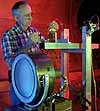| . |  |
. |
|
Kristin Wilson - Lewis News  Cleveland - October 26, 1998 - Ion propulsion, a futuristic technology that for decades catapulted spacecraft through the pages of science fiction novels, will soon be reality. The technology forms the centerpiece of the Deep Space 1 spacecraft that will validate the technology as the primary propulsion for many 21st century spacecraft.
Cleveland - October 26, 1998 - Ion propulsion, a futuristic technology that for decades catapulted spacecraft through the pages of science fiction novels, will soon be reality. The technology forms the centerpiece of the Deep Space 1 spacecraft that will validate the technology as the primary propulsion for many 21st century spacecraft.NASA Lewis researchers developed the ion engine that will propel Deep Space 1 on a journey through the solar system. The engine, which measures approximately 12 inches in diameter, generates thrust by accelerating electrically charged xenon atoms. While these positively charged atoms, called ions, are emitted at speeds topping 68,000 miles per hour, the thrust produced is equivalent only to the pressure of a single sheet of paper held in the palm of the hand. "Although the amount of thrust is very small--approximately 0.02 pounds compared to in space chemical propulsion systems that fire at between 100-500 pounds--it is produced for thousands of hours enabling spacecraft to travel far distances at increasing speeds," explained NASA Lewis engineer James Sovey, On-Board Propulsion Branch. "Ion propulsion will increase the speed of Deep Space 1 by 7,900 miles per hour over the course of the mission." In addition to reduced travel time, ion propulsion, also known as solar electric propulsion, promises a propellant efficiency 10 times that of current chemical systems typically used for on-board propulsion. This increase in efficiency will lower the requirement for on-board propellant mass, which will enable future missions to be launched on smaller, lower-cost launch vehicles. Retired NASA Lewis engineer Dr. Harold Kaufman built and tested the first ion engine in 1959. Several flight tests of the technology followed, most notably NASA's SERT II mission in 1970. Over the years, NASA Lewis researchers worked to refine elements of a primary ion propulsion system. They developed state-of-the-art power and control technologies for integration with a kilowatt-class ion engine and performed ground tests of the systems. In 1992, NASA Lewis and the Jet Propulsion Laboratory (JPL), Pasadena, CA, began developing flight hardware for Deep Space 1 under the NASA Solar Electric Propulsion Technology Applications Readiness (NSTAR) project. NASA Lewis developed a prototype ion engine and a power-processing unit to convert energy captured by solar arrays on Deep Space 1 into 2,300 watts of power for the engine. An 8,000-hour endurance test conducted from 1996-1997 inside a JPL vacuum chamber verified that the engine and its systems have what it takes for long missions. Hughes Electron Dynamics Division, Torrance, CA, was selected to build the first flight engines, power processors, and controllers. "One of the challenges in developing a flight ion propulsion system is packaging the six converters needed to operate the engine," explained John Hamley, chief of the Space Electronic Test Engineering Branch. "The NSTAR team successfully designed and packaged a 2,500 watt power processor into a box 20 inches by 15 inches by 3 inches. The device weighs a little over 15 kilograms and has an efficiency of 93 percent." As NASA's first mission to be flown under the New Millennium program, Deep Space 1 will test 12 advanced technologies and instruments for future interplanetary missions. In addition to ion propulsion, the mission will validate an autonomous optical navigation system, a solar power concentrator array, and an integrated camera and imaging spectrometer. By taking aggressive risks in smaller, faster, and cheaper technology validation missions, the New Millennium program is designed to reduce the risk for tomorrow's missions that will use these revolutionary technologies. The flight will be carried out jointly by the Jet Propulsion Laboratory and Spectrum Astro, Inc. of Gilbert, AZ. As Deep Space 1 breaks free of Earth's gravity it will usher in a new chapter in the history of space exploration. Two weeks after the Delta upper stage gives the spacecraft its final push, the ion engine will kick into full gear. "For all of us who worked to bring ion propulsion to life, it will be a magical moment," Sovey explained. "Having the opportunity to finally demonstrate the technology for planetary mission applications is thrilling."
Deep Space 1 Reports From Spacer.Com
|
| |||||||||
| The content herein, unless otherwise known to be public domain, are Copyright 1995-2016 - Space Media Network. All websites are published in Australia and are solely subject to Australian law and governed by Fair Use principals for news reporting and research purposes. AFP, UPI and IANS news wire stories are copyright Agence France-Presse, United Press International and Indo-Asia News Service. ESA news reports are copyright European Space Agency. All NASA sourced material is public domain. Additional copyrights may apply in whole or part to other bona fide parties. Advertising does not imply endorsement, agreement or approval of any opinions, statements or information provided by Space Media Network on any Web page published or hosted by Space Media Network. Privacy Statement All images and articles appearing on Space Media Network have been edited or digitally altered in some way. Any requests to remove copyright material will be acted upon in a timely and appropriate manner. Any attempt to extort money from Space Media Network will be ignored and reported to Australian Law Enforcement Agencies as a potential case of financial fraud involving the use of a telephonic carriage device or postal service. |